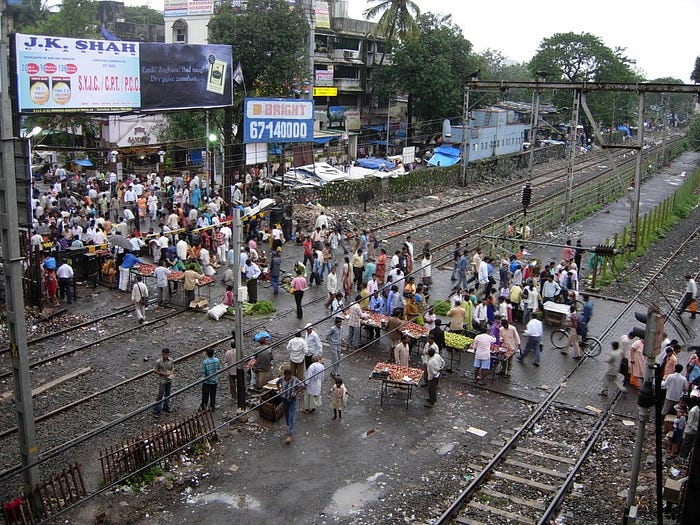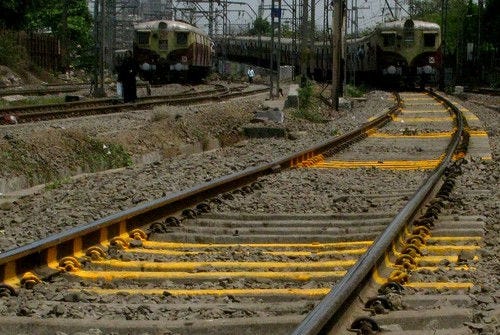medium.com 15 August 2022
It was carried out with only 0.1% of the allocated budget
Mumbai’s suburban network is the world’s busiest urban rail system. It handles 7.5 million commuters daily. The smooth functioning at such a large scale is a spectacle of sorts for the rest of the world.
Whenever I go to Mumbai, I try to get in there. During peak hours, you would see a swarm of people jostling for space on the foot-over bridge and railway platforms minutes before the arrival of a train.
A novice would certainly forebode a stampede. The rapid ease with which a seemingly uncontrollable crowd disperses into respective trains is incomprehensible. It is followed by a brief lull before the next swarm. The cycle repeats itself every few minutes.
The term “organised chaos” describes the orderliness in seemingly chaotic conditions.
The Death Zone
Countless people cross the unmanned rail tracks. 8–10 people die accidental deaths every day. 3000 deaths every year is no mean number. It is equal to the death toll of the 9/11 terror attacks.
These people pass away unnoticed. My friend told me that for daily commuters, it’s a passing event; they don’t even turn their head.
The news media seldom covers it. There is no story around these deaths, no villains to mention. Terror attacks like the 26/11 killed far fewer people but had the whole nation on tenterhooks for many days.
I’m not drawing a comparative chart but trying to underline that the mention of the number of deaths in news headlines makes it catchy only if there is associated sensationalism — a component of heroism and, of course, villainy.
The Bhopal Gas disaster is the world’s worst industrial disaster. It killed around 3000 people in the first few weeks. The headline, however, was captured by the wicked play of Union Carbide and the overnight escape of its top management from the country. The conspiracy theories create a lasting itch in people’s memory.
The Wadala Experiment
The Wadala Experiment, named after the Wadala station on the harbour line, was an initiative by the Indian Railways with the objective of bringing down deaths due to rail crossings.

The rail line runs through dense pockets of population, separated at best by a low wall. Around 2/3 of the central line has slums on either side. The pedestrian bridges are few and far between, and the trains barrel through every couple of minutes.
The rail track bisects Mumbai into east and west, and the most common way for pedestrians to get across is to dash illegally over the unguarded sections of the track.
The experiment is a free-of-charge project conceived by a Mumbai-based “behaviour architecture” consultancy firm named Final Mile. It puts to use the lessons from cognitive psychology which indicate people are instinctive, biased and emotional rather than rational beings.
Over the decades, we have seen advertisers change their tack. Almost all advertisements nowadays tap into our subconscious minds. For instance, in the 50s, a typical Marlboro cigarette ad would highlight the mitigated health hazards of smoking a particular brand. Later, these ads evolved into a snob appeal.
Clothing has become almost nothing about the fabric but style. Drinking coke equals coolness, owning Ikea furniture is the meaning of a “happy family” and wearing a particular perfume makes you an alpha man.
Final Mile tries to translate insights from cognitive neuroscience into kickass marketing strategies. In one instance, they recommended to their eCommerce client that a screen of search results should not throw up many products as it is more likely to confuse a prospective buyer.
Their theories are mostly unorthodox; they attack the primitive part of our brain. Not the rational side.
The Three Interventions
The Wadala experiment is a testimony to the effectiveness of conveying simple messages that appeal to the irrationality of the human mind.
Tackling Leibowitz hypothesis: Final Mile painted five painted and five unpainted sets of railway ties in fluorescent yellow.

The hypothesis was based on the studies of experimental psychologist Herschel W. Leibowitz. He suggests that the human brain is programmed to identify and act on threats posed by small moving objects. We downplay the speed at which large objects move.
As primitive men, we reacted quickly to threats posed by small animals of prey like lions, hyenas, or hunting dogs and underestimated the threat of large animals like elephants or giraffes.
The Final Mile’s recommendation: “The misperception happens because the brain has no frame of reference, no way to evaluate roughly how fast a train is moving.”
With the paint job, the mind can gauge the speed of the train by observing how fast it traverses these ties. This defined the frame of reference for an onlooker.
Graphic depiction: Before the experiment, the warning signpost consisted of lengthy text and stick-figure diagrams. People got used to seeing them. These warning signs were lost in plain sight.
They hired a professional actor to shoot and create a three-part tableau. The extreme close-up of the horror-struck face of a man before being mowed down invokes immediate attention and caution.
The construct was based on the research of Joseph LeDoux, a New York University professor of neuroscience and psychology.
His studies give us invaluable insight into the link between emotion and memory, especially the mechanism of fear. “Emotional memory is stored in the nonconscious part of your brain,” he observes.
The objective of the imagery is to evoke an emotional memory of fear. They fully dispensed with the explanatory text for good.
The pattern of honking: Earlier, loco-drivers used to blow one long warning whistle. They switched to two short, sharp blasting whistles.
A 2007 paper from the Stanford University School of Medicine found that brain activity and human alertness peak during short silences between two musical notes. The paper argues, “The silence sets up a kind of expectation in the brain” — making people conscious of the imminent danger.
The simple changes cost a few thousand dollars instead of the budgeted seven million. These small measures resulted in a 70% reduction in deaths in six months’ time.
Biju Dominic, the CEO of Final Mile, is credited with what he calls “small psychological nudges,” or unconscious interventions with significant outcomes.
In one instance he noticed the right-hand corridors outside his office are painted red with Paan spits. People used to spit, he observed, when they thought they are alone. So he painted crude pictures of men on the right-hand walls to marginally reduce the feeling of solitude.
These theories work on a simple principle: To bring people’s unconscious behaviour into the realm of awareness.
